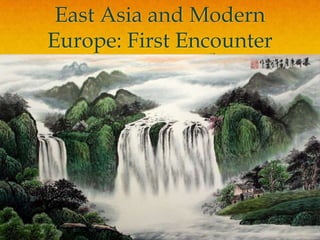
East Asia and Modern Europe: First Encounter - The Spread of Christianity
- 1. East Asia and Modern Europe: First Encounter
- 5. The Portuguese in East Asia The Portuguese reached India in 1498, China in 1514, and Japan in 1543. They established their Asian headquarter in 1510 at Goa and 1511 they captured Malacca. Spices: to make meat palatable, medicine and religious ceremonies. Superior ships, weaponry and seamanship, they derived income from transporting goods like SEA spices to China, Chinese silk to Japan, and Japanese silver to China.
- 6. The Portuguese in East Asia They used their profits from this trade to purchase spices and other products for European markets. What they had to do was to secure entry into China and Japan. Not waiting for official permission to trade, they engaged in illegal commerce and even built a fort in Lintin Island. In 1557 an arrangement was reached permitting the Portuguese to establish themselves in Macao, ceded to Portugal in 1887.
- 7. The Jesuits in Japan Missionary work was also important: mid-16th century Goa boasted some 80 churches and convents. The great pioneers were the Jesuits, members of the Society of Jesus. In 1549, St. Francis Xavier, one of the original members of the Society, landed on Kyushu. Donald Lach has summarized the qualities that the Jesuits found to admire in the Japanese: “their courtesy, dignity, endurance, frugality, equanimity, indu striousness, sagaciousness, cleanliness…….”
- 8. The Jesuits in Japan (cont.) They criticized the Japanese propensity for suicide and also found fault with the “disloyalty of vassal to master,….,their inhuman treatment of enemies,…., their failure to respect rule of law, and their unwillingness to give up the system of concubinage.” The Jesuits tried to win acceptance by adapting themselves to local manners and customs. The Jesuits father’s strategy was to work from the top by converting the rulers and then allowing the faith to seep down to the populace at large. This approach met with considerable success in Kyushu, but not long lasting. The Jesuits themselves became involved in this trade and in politics and later they realized that real progress of their mission depended on the will of the central government.
- 10. The Impact of other Europeans The Dutch arrived in 1571 with imperialist ambitions The English Protestants arrived in the early 1600s The Spanish commanded the precious metals-the silver
- 12. The Closing of Japan In 1606 Christianity was declared illegal, and in 1614 he undertook a serious campaign to expel the missionaries. By 1614 there were over 300,000 converts in Japa. The destruction of Christianity was long and painful. Tortures such as hanging a man upside down with his head in a pit filled with excrement… In its suppression, some 37,000 Christians lost their lives. The Japanese saw Christianity as potentially subversive of the political order and basic social structure. The Spaniards were expelled in 1624, one year after the English had left voluntarily. The Portuguese were also expelled.
- 14. The Jesuits in Vietnam The first Europeans to arrive in Vietnam were Portuguese adventurers and traders. In 1525 they established a trading center at Hoi An. Father Alexander de Rdodes arrived in Vietnam in 1624, a church had already existed in Danang. Although the Jesuits sought to work from the top down, and did convert a Nguyen princess, government policy under both Nguyen and Tinh vacillated from tolerance. By 1640 there were a reported 39,000 converts in central Vietnam and 82,000 in the north.
- 15. The Jesuits in China Then Valognano established a special training center in Macao so that missionaries could study the Chinese language and culture in preparation for worn in China. The outstanding pioneer was Matteo Ricci (1551-1619). They were particularly successful in demonstrating the superior accuracy of European astronomical predictions, chiefly Adam Schall von Bell (1591-1666) and Ferdinand Verbiest (1633-1688). The emperor accepted the Jesuits’ science with alacrity and took their quinine for the sake of his health. But they were less successful in spreading the religion.
- 16. The Jesuits in China (cont.) “ I had asked Verbiest why God had not forgiven his son without making him die, but thought he had tried hard to answer I had not understood him” The high point for early Catholicism in China came in the middle years of Kangi’s reign, but by 1700 there were no more than 300,000 Christian Chinese.
- 17. The Rites Controversy It revolved around the question of the proper attitude a Christian should adopt toward Confucian doctrines and practices. The Jesuits turned Confucius into a religious teacher, while the Dominicans held that the ancient Chinese were atheists. The Jesuits claimed that some ceremonies were nonreligious and therefore permissible, but the Dominicans disagreed.
- 18. The Decline of Christianity in China In 1704 the pope condemned Chinese rituals, and in 1742 a decree was issued to settle all points against the Jesuits. Powerful emperors like Kangxi, however, resented Rome’s claim of authority over their subjects, and they saw no reason to abide by the papal judgment. Christianity was forbidden in 1724 By the end of 18th century, the number of converts had been reduced to about half.
- 19. Trade with the West and the Canton System Qianlong opened a special area in Canton to set aside for the warehouses (factories) of foreign traders. Foreign traders were required to deal with a group of Chinese merchants who had been granted a monopoly on foreign trade. The foreigners were not granted direct access to Chinese officials, nor government-to-government relations. Foreign maritime trade were taxed higher that Chinese one The system continued to operate until China faced a Europe that could no longer be contained.
- 21. Portrait of a Japanese Girl experimenting with Western Dress
- 25. Group discussion Opium War, The Mongol’s Occupation of the World, Great Wall of China, The Closing of Japan, Japanese War in China and Korea South China Sea Dispute Marco Polo (1254-1324) Tubeplus.me
